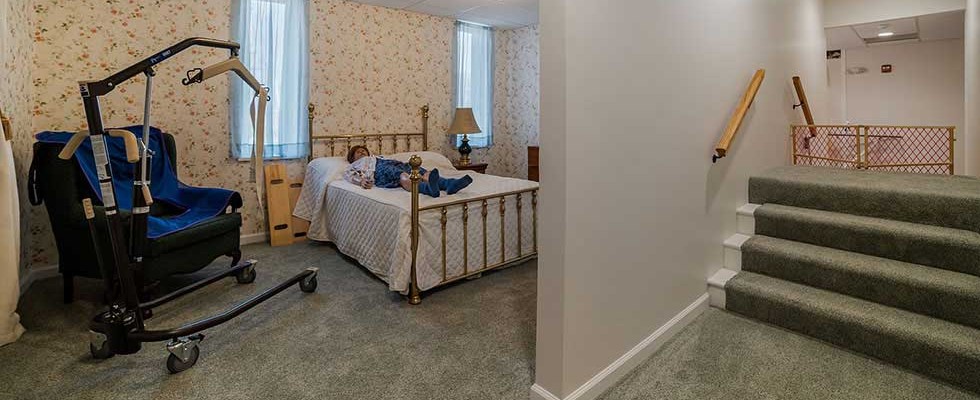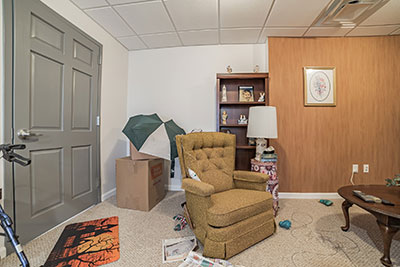
Mari Baxter remembers looking around a conference table and thinking there had to be a better way to train caregivers.
Baxter, who is chief operating officer for Senior Helpers, had spent months traveling the country checking out how her company onboarded staff. Like so many other homecare companies then and now, much of the training was passive, with new employees sitting and listening to lectures.
“It was an old way of doing things—it wasn’t just the way that we did it,” Baxter said. “Just caregivers around a conference table and someone telling them ‘you can or can’t do this’ and then moving on. … I didn’t find any energy and I didn’t find any passion. And I saw so many flaws within our own training.”
Building a Plan From Scratch
So she started thinking about how to approach training differently. She remembered visiting a franchisee in Wisconsin who had set up some of the more complex equipment in his office to use to assess caregivers: gait belts, wheelchairs, a hospital bed, a Hoyer lift. With that in the back of her mind, she went to her boss and asked if, as part of renovations to a new office for their corporate location in Baltimore, Maryland, there was room to add an apartment.
Her boss said yes—and now, caregivers receiving training there step into a 1,500-square-foot unit outfitted with the familiar decor of an octogenarian’s house—wood paneled walls, teapot wallpaper, linoleum floors, a gold couch, worn carpeting. There’s even a baby picture of Baxter in a big wooden frame. “Everyone walks in and says, ‘Oh my gosh, it’s like I’m walking into my grandma’s,’” she said.
The mock apartment is also full of possible dangers, including both wooden and carpeted steps and a low, regular bed.
In fact, when a new training class arrives at the apartment, their first assignment is often to find a certain number of common hazards against the clock, escape room-style—with the most successful winning a gift card.
“We have all the realities of clientele—dog bones on the floor, dog leashes on the floor, the typical ground outlet with 50 things plugged into it with an extension cord, a laundry basket sitting on the wheelchair pillow, expired food, a paper towel roll on top of the stove,” Baxter said. “There so many things you can encounter—the coffee table too close to the couch, a cigarette and ashtray next to an oxygen tank.”
Other parts of the curriculum include working with a mannequin to learn proper lifts and transfers, bathing and changing of bed linens, or understanding the concepts behind safe feeding. Those who successfully complete each area receive a certificate in, say, kitchen safety to add to their resume.
Baxter said the training is more fun for those going through it and seems to stick better. It also has an impact on both recruiting and retaining caregivers, Baxter said. Although she didn’t want to share the company’s data on the program, the “Centers of Excellence,” as Senior Helpers’ training setups are called, have been adopted across the country at both corporate offices and individual franchises. Some franchisees have tried a more minimal model, using a storage unit for occasional sessions or renting time in an apartment-style hotel suite.
“(Potential caregivers) will call up and say, is this the place that has the cool training?” Baxter said. “That means we’ve accomplished our mission, when you start getting people wanting to come back to work because you’re making training fun and exciting.”

From welcome mats to extension cords, the Center of Excellence includes real-life examples of some of the hazards caregivers may encounter entering the home. Source: Senior Helpers.
Beyond Basic Training
Training employees just wasn’t enough. Baxter also wanted to solve another problem: educating family caregivers.
“When we take a client, we can be with them from 9 to 5 or midnight to 6 and we’re doing our best, our caregiver does a great job—and then we get a call on Monday morning that the client’s daughter was visiting and she didn’t know how to get her mother into the bathtub and she dropped her and now she’s in the hospital,” Baxter said.
So Senior Helpers began to offer “family nights” in the apartment, where clients’ family members can come in to learn how to safely bathe their loved one, or change the sheets without moving them, or load them safely into a car or a wheelchair—with staff, caregivers or a 50-pound test dummy playing the role of the patients.
“We teach the family members how to get more confidence with their own equipment,” Baxter said. “Teaching the families became very valuable to us. The families also became so grateful.”
Senior Helpers also uses the training as a marketing point with potential clients and with referral sources.
“I wanted to be able to walk into any kind of assisted living or independent living or any place that is giving us referrals and saying, ‘we don’t just sit around a table, we train them differently—come watch one of our trainings.’”
Upskilling & Support
There was one more angle Baxter wanted to cover, and that was offering support to existing caregivers, whether through refresher training or upskilling — and sometimes just the chance to connect to their peers.
“Being a caregiver is so undervalued and unappreciated. They work harder than any human being,” Baxter said. “They’re subjected to verbal abuse. … they have to do things like hygiene for grown adults. … I think caregivers are some of the most undervalued, most wonderful human beings, but burnout can come for anybody.”
In addition to family nights, Senior Helpers now offers the apartment up to caregiver book clubs and movie nights.
“We’ll show a movie about dementia or Alzheimer’s and have popcorn and pizza and talk [about the film]. We let the caregivers come in and sit in the apartment and talk about their own client relationships.”
That allows the caregivers to vent (in a HIPAA-compliant fashion) and find solutions for some of their thornier client issues. And this approach to training is paying off, Baxter said.
“Our retention in our corporate stores where they have the training is unbelievable. We don’t lose the caregivers,” she said. “That was really what our goal was. And we keep bringing them back for more fun, exciting training. It’s just been such a game changer for us. Because I love to see their smiles, I love to see their faces and having them say that this training made such a difference for them.”
